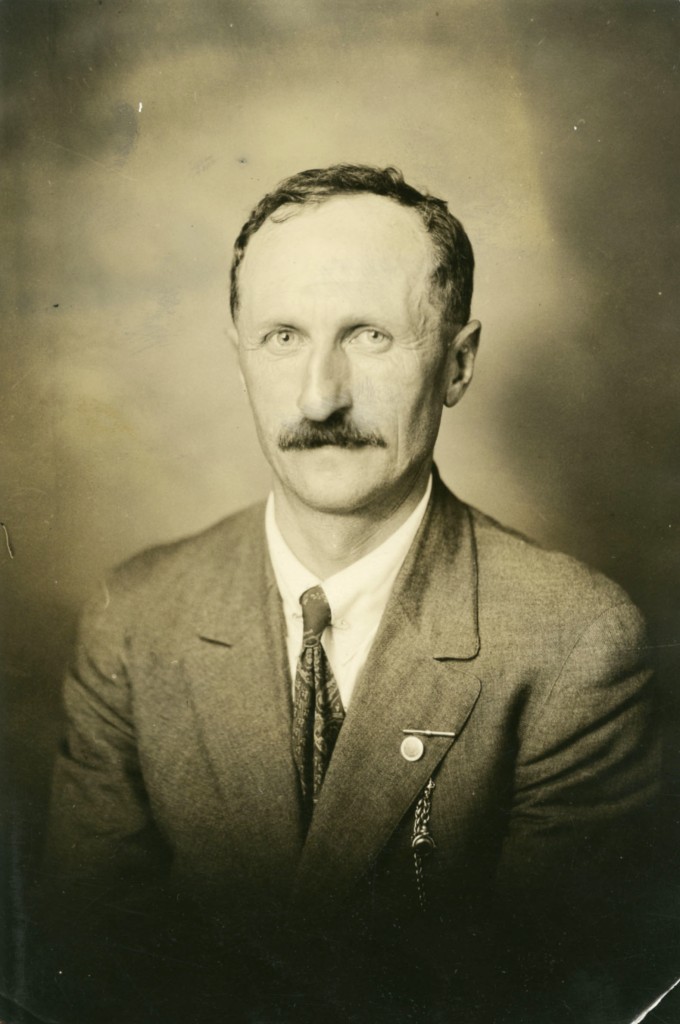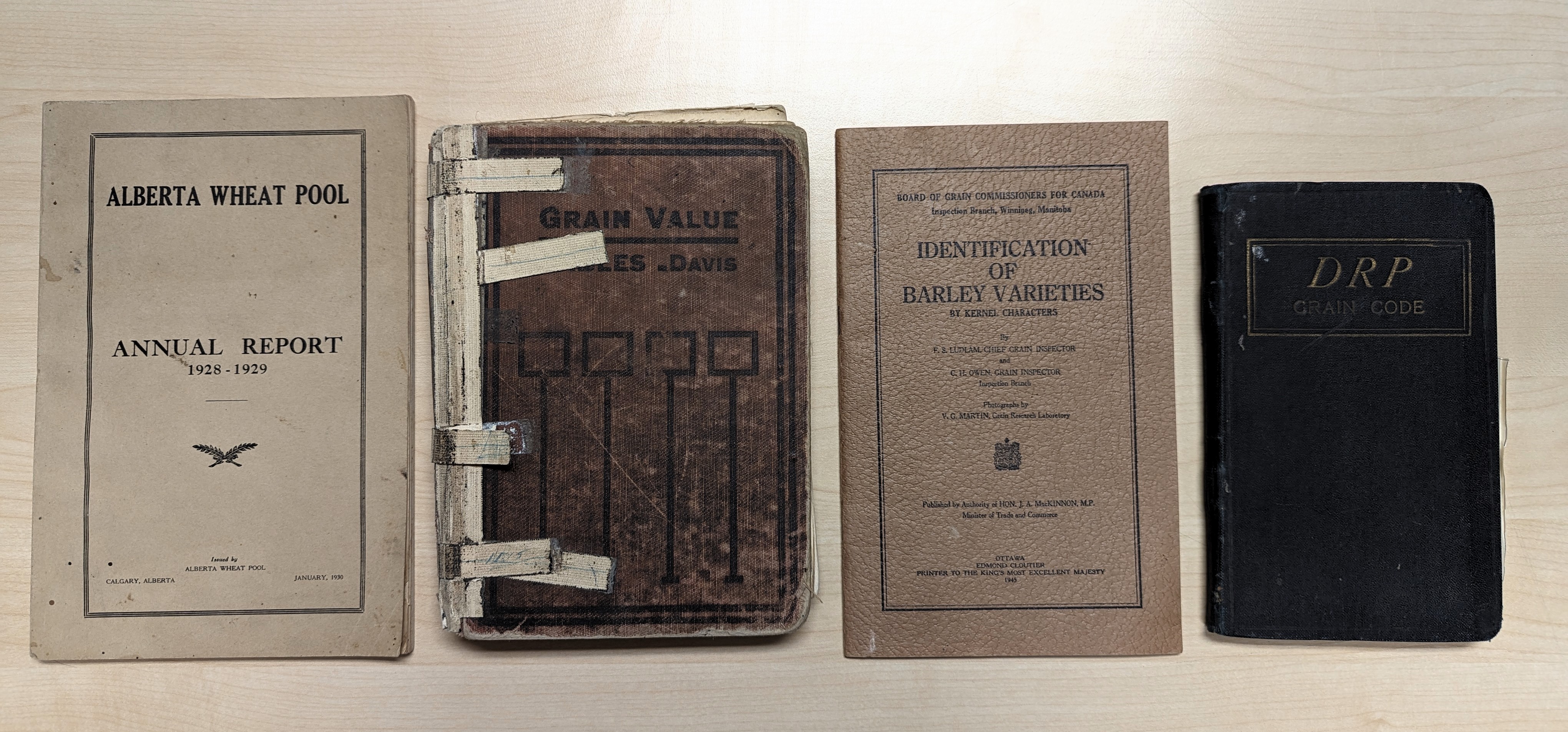October marked the centennial of the creation of the Alberta Wheat Pool, a cooperative which formed in response to the plummeting price of grain that saw farmers bear the brunt of the economic loss. This is a significant occasion to recognize, as the Pool is considered the first farmers co-operative on the Canadian Prairies. The United Farmers of Alberta (UFA) were a driving force behind the Wheat Pool, and in addition, the UFA government was in power during the Pool’s formation. This blog post will look at how the Alberta Wheat Pool came to be, the Pool’s connection to UFA and the key figures who brought organized grain marketing to the forefront.

The idea of better assistance with grain marketing goes back even further than the Wheat Pool, as it had been a concern that farmers had been seeking a solution to for years. After UFA formed in 1909, grain marketing soon became a pivotal issue, prompting UFA to become the driving force in the push for grain marketing organization. In 1913 under UFA’s second President, William Tregillus, the Alberta Farmers Co-operative Elevator Company was formed to market the grain of its members. Within 4 years, over 50 grain handling facilities were established. In 1917, the Grain Growers’ Grain Company (which had been founded in 1906) and the Alberta Farmers’ Co-operative Elevator Company merged to become the United Grain Growers Ltd. (UGG).
By 1923, farmers in Alberta were producing upwards of 145 million bushels of grain, an amount that had quadrupled since 1905. But grain products were still being devalued, and prices dropped significantly after the First World War even though the demand still existed. This, in combination with high freight rates and taxation, meant that farmers struggled to market their grain and turn a profit. UFA President Henry Wise Wood knew that an improved grain marketing strategy was needed, and increased competition to the existing grain organization co-ops, so he spent years looking for a viable solution to assist UFA members. Wood brought the grain marketing issue to the forefront, and included issues and concerns prominently in The U.F.A. publication to encourage UFA members and Locals to get involved with these conversations.
At the UFA’s annual convention in January of 1923, the central UFA board brought forward resolutions to lobby the government for a federal wheat board for the provinces of Alberta, Saskatchewan and Manitoba, or a provincial wheat board if a federal wheat board could not be established. Members passed the motions almost unanimously, but despite farmers urging their government for legislated grain marketing, the onus was put on farmers to organize their own voluntary wheat pool. After the convention, a Wheat Pool committee was appointed to pursue its formation, which included UFA members and representatives from the United Grain Growers.
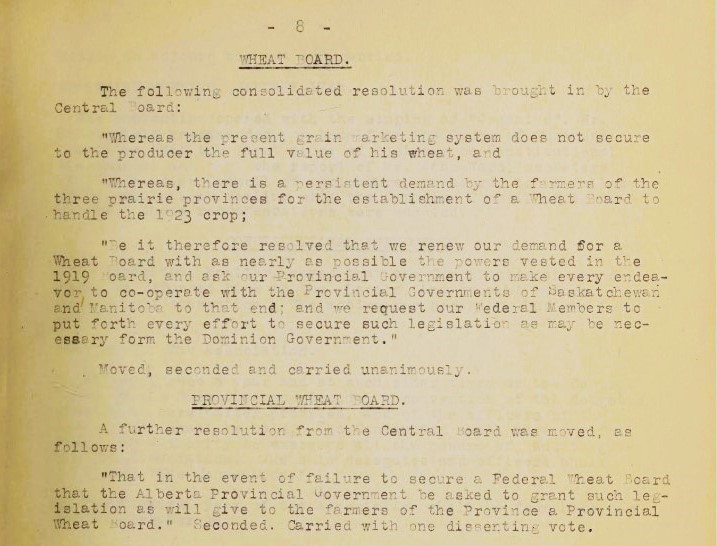
In the summer of 1923, San Francisco lawyer Aaron Sapiro had made his way to Alberta. Sapiro was known for his involvement in the American agricultural cooperative movement, and was invited to Alberta to speak to farmers on the subject of organizing a Wheat Pool. Sapiro was able to clearly articulate how an Alberta Pool would work, including details on contracts, term lengths, cost to farmers, and how commodities would be marketed at the best price. Sapiro even had a plan on how to raise the funds to get the Pool up and running as soon as possible – not through government, but with bank loans and fundraising. Henry Wise Wood, and the UFA, then stepped in to make the Pool a reality, even lending out their office space and staff to assist with the wheat Pool’s setup. UFA already had a loyal membership base and relationships with suppliers and buyers to facilitate operations.

In just a few weeks, the Alberta Wheat Pool signed up over 26,000 members. Memberships were $3 with $2 going to the organization and $1 for a stock share. The UFA utilized its organizational strength to reach farmers across the province, meeting them in UFA halls, schools, villages and towns, and relaying the benefits of joining the Pool. Even cabinet members in the UFA government joined the membership drive, further legitimizing its cause. With the membership campaign a success, the Alberta Co-operative Wheat Producers Ltd. was established on October 29, 1923 and was soon known as the Alberta Wheat Pool.
The main idea behind a Pool was that farmers would ‘pool’ their wheat together so that everyone could rely on price stability. The way the Pool worked was by paying farmers in advance for a conservative price estimate of their product at the time of delivery, then a subsequent payment when grain was sold to market, and then a final payment at the crop year’s end once harvest operations had ceased. A Pool also united farmers and increased their bargaining strength when negotiating prices and payments.
Members agreed to five-year contracts for grain marketing, and this gave the Pool a strong foothold in the market. In the first year of operation, Pool members received 29 cents per bushel more than non-pool members. Initially it contracted the use of the province’s existing elevators for storage and shipping facilities, but the Pool was soon able to construct a network of elevators which eventually dominated the industry in Alberta. The Red Deer Advocate reported that the Alberta Wheat Pool was “the most successful co-operative marketing enterprise” for wheat in North America at the time. The Alberta Wheat Pool was off to a strong start, and even encouraged Saskatchewan and Manitoba to form their own Pools.
Henry Wise Wood became the president of the Alberta Wheat Pool from 1923 to 1937 (he was also UFA president from 1916 to 1931). A provisional Pool board consisted of active UFA members including Stephen Lunn, Chris Jensen, and Lew Hutchinson, as well as non-UFA farmers, representatives from the trade and banking sectors, and government representative John E. Brownlee. Brownlee, Attorney-General for the UFA government, was appointed to assist with the Wheat Pool’s set-up, and drafted the contracts for membership and for utilizing the existing grain elevators. Later on, directors were elected from the Wheat Pool’s membership.
The Alberta Wheat Pool further became connected to UFA by way of The U.F.A. publication which had regular updates in the section titled “Official News of the Alberta Wheat Pool”. Here news and reports were circulated to members, including convention proceedings and financial standings. The U.F.A. became the “official organ” for the Alberta Wheat Pool, as well as for other provincial marketing pools such as the Alberta Dairy Pool and Alberta Livestock Pool.
By 1929, membership in the Alberta Wheat Pool had grown to 41,000 and had 439 of its own elevators. In addition, the Pool had terminals at Vancouver and Prince Rupert to ship grain internationally from the west coast. The Pool was soon responsible for 27.6% of Canada’s total wheat exports.

However, in the fall of 1929, the New York stock market collapsed, declining the price of stocks and commodities and severely disrupted the world’s economy. Wheat reached its lowest price point in 400 years. Although wheat Pools across Canada fought hard to maintain grain prices in order to protect their Pools and its members, this was seen as going against the principles of supply and demand which was not meant to be interfered with by individuals, businesses, or government. The Pools were unable to stabilize the price of grain on their own, further worsening the impacts of the Great Depression, which led to the federal government introducing a wheat price stabilization policy. This policy meant that provincial governments issued bonds to banks to cover the deficiencies, and in turn, the Pool issued bonds to their government. Patronage dividends were discontinued for a decade to concentrate on repaying this debt, which took the Alberta Wheat Pool until 1947 to completely pay off to the Alberta government. The Great Depression showed that individual Pools had limited power in times of crisis. It was the federal government that had the means to collectively keep the Pools afloat, which ultimately led to the formation of the Canadian Wheat Board in 1935.
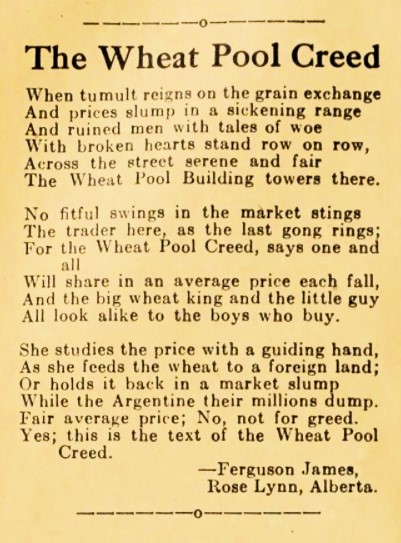
By 1964, the Alberta Wheat Pool owned 543 elevators and 603 storage facilities in Alberta and British Columbia. In the 39 years since the Pool’s first elevators were built, they handled a total of 1,780,361,100 bushels of grain, 1,568,654 bushels of cereal seed, 86,965,801 pounds of forage seeds and 414,681 bushels of rapeseed (see canola) or mustard seed. Up to this point, almost $41 million had been distributed in patronage funds to its members.
In 1998, the Alberta Wheat Pool, along with Manitoba Pool Elevators, merged to form Agricore Cooperative Ltd., ending the Alberta farmer owned cooperative. Only a few years later, Agricore merged with United Grain Growers to become Agricore United. Today, there are original grain elevators in existence, some of which still bear the Alberta Wheat Pool name (see Alberta Grain Elevators). While no longer operational, they visibly represent Alberta’s early grain marketing cooperatives and the significant role they had for farmers, their communities and beyond. The UFA was integral in the creation of the Alberta Wheat Pool, including its organization, membership, and the key people who advocated for a provincial Wheat Pool. A century later, the Alberta Wheat Pool represents a successful farmer owned and controlled cooperative, that grew to become one of the largest grain-handling cooperatives in Canada.
Written by Erin Hoar, Archivist
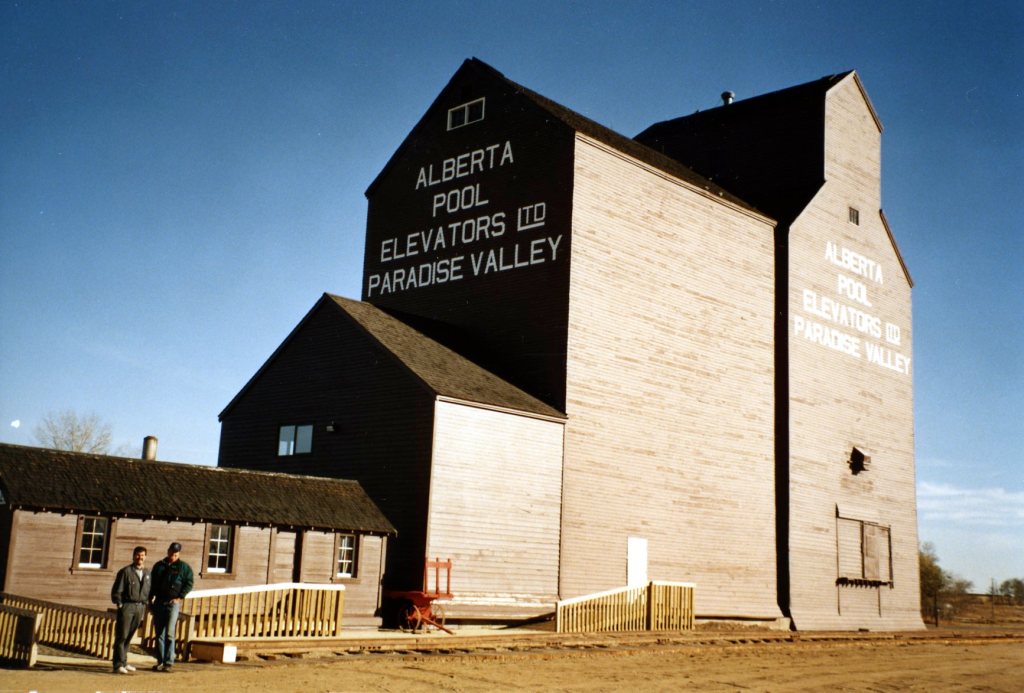
References & Further Reading:
Alberta Wheat Pool. The Story of the Alberta Wheat Pool: “Farmer owned co-operative”. Calgary: s.n, 1951. http://peel.library.ualberta.ca/bibliography/7244.html
Alberta Wheat Pool Collection (Fonds 35). In custody of the United Farmers Historical Society. https://archives.ufa.com/permalink/descriptions8752.
Collins, Robert. “An idea whose time had arrived, the Wheat Pool bursts into being” in Alberta in the 20th Century: Brownlee and the Triumph of Populism 1920-1930 ed. Ted Byfield. United Western Communications Ltd.: Edmonton, 1996. Pp. 36-51.
Earl, Paul D. 2019. The Rise and Fall of United Grain Growers : Cooperatives Market Regulation and Free Enterprise. Winnipeg: University of Manitoba Press.
Nesbitt, Leonard D. Tides in the West: A Wheat Pool Story. Printed by Modern Press 1962.
Pamphlets about compulsory membership in wheat pools. (Fonds 1, Series 11, File 6). In custody of the United Farmers Historical Society. https://archives.ufa.com/permalink/descriptions7645
Pearson, Jim A.. “Alberta Wheat Pool.” The Canadian Encyclopedia. Historica Canada. Article published April 21, 2013; Last Edited March 04, 2015. https://www.thecanadianencyclopedia.ca/en/article/alberta-wheat-pool
Tolton, G. (2009). Deep Roots. Promising Future. Calgary: UFA, pp. 81-82. Retrieved from https://archives.ufa.com/viewer/deep-roots-promising-future?p=12&type=static
United Farmers of Alberta. “Alberta Wheat Pool Record of Progress” in The U.F.A. Co-operator, Vol.3, No. 8. Sept. 1965, p. 10. https://archives.ufa.com/permalink/cooperator3_8-11






